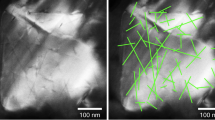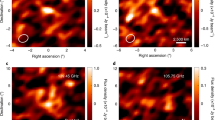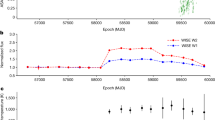Abstract
Interplanetary dust particles hit the surfaces of airless bodies in the Solar System, generating charged1 and neutral2 gas clouds, as well as secondary ejecta dust particles3. Gravitationally bound ejecta clouds that form dust exospheres were recognized by in situ dust instruments around the icy moons of Jupiter4 and Saturn5, but have hitherto not been observed near bodies with refractory regolith surfaces. High-altitude Apollo 15 and 17 observations of a ‘horizon glow’ indicated a putative population of high-density small dust particles near the lunar terminators6,7, although later orbital observations8,9 yielded upper limits on the abundance of such particles that were a factor of about 104 lower than that necessary to produce the Apollo results. Here we report observations of a permanent, asymmetric dust cloud around the Moon, caused by impacts of high-speed cometary dust particles on eccentric orbits, as opposed to particles of asteroidal origin following near-circular paths striking the Moon at lower speeds. The density of the lunar ejecta cloud increases during the annual meteor showers, especially the Geminids, because the lunar surface is exposed to the same stream of interplanetary dust particles. We expect all airless planetary objects to be immersed in similar tenuous clouds of dust.
This is a preview of subscription content, access via your institution
Access options
Subscribe to this journal
Receive 51 print issues and online access
$199.00 per year
only $3.90 per issue
Buy this article
- Purchase on Springer Link
- Instant access to full article PDF
Prices may be subject to local taxes which are calculated during checkout




Similar content being viewed by others
References
Auer, S. & Sitte, K. Detection technique for micrometeoroids using impact ionization. Earth Planet. Sci. Lett. 4, 178–183 (1968)
Collette, A., Sternovsky, Z. & Horányi, M. Production of neutral gas by micrometeoroid impacts. Icarus 227, 89–93 (2014)
Hartmann, W. K. Impact experiments: 1. Ejecta velocity distributions and related results from regolith targets. Icarus 63, 69–98 (1985)
Krüger, H., Krivov, A., Hamilton, D. & Grün, E. Detection of an impact-generated dust cloud around ganymede. Nature 399, 558–560 (1999)
Spahn, F. et al. Cassini dust measurements at Enceladus and implications for the origin of the E ring. Science 311, 1416–1418 (2006)
McCoy, J. E. Photometric studies of light scattering above the lunar terminator from Apollo solar corona photography. Proc. Lunar Sci. Conf. 7, 1087–1112 (1976)
Zook, H. A. & McCoy, J. E. Large scale lunar horizon glow and a high altitude lunar dust exosphere. Geophys. Res. Lett. 18, 2117–2120 (1991)
Glenar, D. A., Stubbs, T. J., Hahn, J. M. & Wang, Y. Search for a high-altitude lunar dust exosphere using Clementine navigational star tracker measurements. J. Geophys. Res. Planets 119, 2548–2567 (2014)
Feldman, P. D. et al. Upper limits for a lunar dust exosphere from far-ultraviolet spectroscopy by LRO/LAMP. Icarus 233, 106–113 (2014)
Elphic, R. C. et al. The Lunar Atmosphere and Dust Environment Explorer mission. Space Sci. Rev. 185, 3–25 (2014)
Iglseder, H., Uesugi, K. & Svedhem, H. Cosmic dust measurements in lunar orbit. Adv. Space Res. 17, 177–182 (1996)
Krivov, A. V., Sremčević, M., Spahn, F., Dikarev, V. V. & Kholshevnikov, K. V. Impact-generated dust clouds around planetary satellites: spherically symmetric case. Planet. Space Sci. 51, 251–269 (2003)
Buhl, E., Sommer, F., Poelchau, M. H., Dresen, G. & Kenkmann, T. Ejecta from experimental impact craters: particle size distribution and fragmentation energy. Icarus 237, 131–142 (2014)
Stern, S. A. The lunar atmosphere: history, status, current problems, and context. Rev. Geophys. 37, 453–492 (1999)
Sremčević, M., Krivov, A. V., Krüger, H. & Spahn, F. Impact-generated dust clouds around planetary satellites: model versus Galileo data. Planet. Space Sci. 53, 625–641 (2005)
McNamara, H. et al. Meteoroid Engineering Model (MEM): a meteoroid model for the inner Solar System. Earth Moon Planets 95, 123–139 (2004)
Dikarev, V. et al. The new ESA meteoroid model. Adv. Space Res. 35, 1282–1289 (2005)
Nesvorný, D. et al. Dynamical model for the zodiacal cloud and sporadic meteors. Astrophys. J. 743, 129 (2011)
Rennilson, J. J. & Criswell, D. R. Surveyor observations of lunar horizon-glow. Moon 10, 121–142 (1974)
Glenar, D. A., Stubbs, T. J., McCoy, J. E. & Vondrak, R. R. A reanalysis of the Apollo light scattering observations, and implications for lunar exospheric dust. Planet. Space Sci. 59, 1695–1707 (2011)
Markwardt, C. B. in Astronomical Data Analysis Software and Systems XVIII (eds Bohlender, D. A., Durand, D. & Dowler, P.) ASP Conf. Ser. 411, 251 (2009); preprint at http://arxiv.org/abs/0902.2850
Horányi, M. et al. The Lunar Dust Experiment (LDEX) onboard the Lunar Atmosphere and Dust Environment Explorer (LADEE) mission. Space Sci. Rev. 185, 93–113 (2014)
Dietzel, H. et al. The HEOS 2 and HELIOS micrometeoroid experiments. J. Phys. E 6, 209–217 (1973)
Saito, Y. et al. Solar wind proton reflection at the lunar surface: low energy ion measurement by MAP-PACE onboard SELENE (KAGUYA). Geophys. Res. Lett. 35, L24205 (2008)
Saul, L. et al. Solar wind reflection from the lunar surface: the view from far and near. Planet. Space Sci. 84, 1–4 (2013)
Allegrini, F. et al. Lunar energetic neutral atom (ENA) spectra measured by the interstellar boundary explorer (IBEX). Planet. Space Sci. 85, 232–242 (2013)
Poppe, A. R., Halekas, J. S., Szalay, J. R., Horányi, M. & Delory, G. T. Model-data comparisons of LADEE/LDEX observations of low-energy lunar dayside ions. Lunar Planet. Sci. Conf. Abstr. 45, 1393 (2014)
Sremčević, M., Krivov, A. V. & Spahn, F. Impact-generated dust clouds around planetary satellites: asymmetry effects. Planet. Space Sci. 51, 455–471 (2003)
Auer, S. in Interplanetary Dust (eds Grün, E., Gustafson, B., Dermott, S. & Fechtig., H.) 387–438 (Springer, 2001)
Krüger, H., Krivov, A. V. & Grün, E. A dust cloud of Ganymede maintained by hypervelocity impacts of interplanetary micrometeoroids. Planet. Space Sci. 48, 1457–1471 (2000)
Koschny, D. & Grün, E. Impacts into ice-silicate mixtures: ejecta mass and size distributions. Icarus 154, 402–411 (2001)
Grün, E., Zook, H. A., Fechtig, H. & Giese, R. H. Collisional balance of the meteoritic complex. Icarus 62, 244–272 (1985)
Drolshagen, G. Comparison of Meteoroid Models. IADC Report No. 24.1 (Inter-Agency Space Debris Coordination Committee, 2009)
Acknowledgements
The LADEE/LDEX project was supported by NASA. Tests and calibrations were done at the dust accelerator facility of the University of Colorado, supported by NASA’s Solar System Exploration Research Virtual Institute (SSERVI). We are grateful for engineering and technical support from the Laboratory for Atmospheric and Space Physics (LASP), especially from M. Lankton (project manager), S. Gagnard and D. Gathright (mission operations), and D. James (calibration).
Author information
Authors and Affiliations
Contributions
M.H. was the instrument principal investigator, directed the data analysis, and was primarily responsible for writing this paper. J.R.S. developed the data analysis software. S.K. was responsible for the calibration of the instrument and contributed to the data analysis. J.S. led the modelling effort. E.G. and R.S. contributed to the analysis and interpretation of the data. Z.S. designed the instrument and contributed to the data analysis.
Corresponding author
Ethics declarations
Competing interests
The authors declare no competing financial interests.
Extended data figures and tables
Extended Data Figure 1 Detection geometry.
A particle of velocity v is recorded by a detector of sensitive area A. The surface normal of the detector area points along the velocity vector of the spacecraft vsc. The particle enters the instrument with an angle ω measured between the instrument boresight and the relative velocity vector of the particle vsc − v .
Extended Data Figure 2 Systematic approximation error and its dependence on ejection parameters.
a, The calculated density for a standard set of parameters listed in Extended Data Table 1 for the model ejecta cloud12 as function of altitude (black line) normalized to the production rate N+. The density is recalculated using n = γ/(Avsc) (red line), the approach taken in this paper to infer the dust density from the measured impact rates γ, indicating an underestimate of <20% for altitudes below 100 km. b, Contour plot of the ratio of the ‘true’ model density over the recalculated density at the altitude h = 50 km, as a function of the opening cone angle of the ejecta plume ψ0 and the exponent of the power-law initial-speed distribution µ, appropriately setting the minimum speed u0, while keeping the maximum speed constant at 2vescape, maintaining a constant total kinetic energy of the ejecta particles.
Extended Data Figure 3 Comparison of observed and modelled cloud properties.
a, The dust density n(h) of the lunar ejecta cloud as function of altitude and size (colour scale). The continuous black line shows the model prediction12 using the best-fit parameters listed in Extended Data Table 1. b, The cumulative dust mass in the lunar exosphere. The continuous blue line shows the ejecta model prediction (Extended Data Table 1). c, The initial normalized vertical velocity distribution f(u) calculated from n(h) using energy conservation. The continuous line shows f(u) ∝ u−3.4 ± 0.1 matched to the data at u ≥ 400 m s−1 (altitude h ≈ 50 km). Error bars were calculated by propagating the  error through the various calculations, where N is the number of detected dust impacts.
error through the various calculations, where N is the number of detected dust impacts.
Extended Data Figure 4 Modelled flux and mass production in the lunar equatorial plane.
a, The calculated flux of interplanetary dust particles Fimp reaching the lunar equatorial region as a function of lt and t (colour coded for monthly averages). b, The mass production rate, equation (9), calculated using a model for the spatial and velocity distributions of interplanetary dust particles near the Earth16, consistent with the observed asymmetric dust cloud.
Rights and permissions
About this article
Cite this article
Horányi, M., Szalay, J., Kempf, S. et al. A permanent, asymmetric dust cloud around the Moon. Nature 522, 324–326 (2015). https://doi.org/10.1038/nature14479
Received:
Accepted:
Published:
Issue Date:
DOI: https://doi.org/10.1038/nature14479
This article is cited by
-
Fine-grained regolith loss on sub-km asteroids
Nature Astronomy (2022)
Comments
By submitting a comment you agree to abide by our Terms and Community Guidelines. If you find something abusive or that does not comply with our terms or guidelines please flag it as inappropriate.



